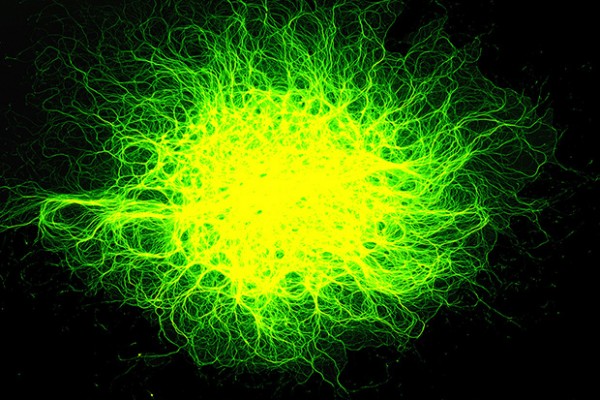New target identified in fight against Alzheimer’s, multiple sclerosis
Highlighting a potential target in the treatment of
multiple sclerosis (MS) and Alzheimer’s disease, new research suggests
that triggering a protein found on the surface of brain cells may help
slow the progression of these and other neurological diseases.
‘Flicker: Your Brain on Movies’
Why do so many of us cry at the movies? Why do we flinch when Rocky Balboa takes a punch? What’s really happening in our brains as we immerse ourselves in the lives being acted out on screen? These are the questions that Washington University in St. Louis neuroscientist Jeffrey M. Zacks, PhD, explores in his new book, “Flicker: Your Brain on Movies.”
Damage to brain networks affects stroke recovery
Initial results of an innovative study may significantly change how some patients are evaluated after a stroke, according to School of Medicine researchers. Shown is the study’s senior author, Maurizio Corbetta, MD.
Different forms of Alzheimer’s have similar effects on brain networks
Brain networks break down in a similar fashion in rare, inherited forms of Alzheimer’s disease and much more common uninherited versions of the disorder, reveals a new study led by the School of Medicine’s Beau Ances, MD, PhD.
Scientists find new clues to brain’s wiring
New research provides an intriguing glimpse into the processes that establish connections between nerve cells in the brain. These connections, or synapses, allow nerve cells to transmit and process information involved in thinking and moving the body. Pictured is the study’s senior author, Azad Bonni, MD, PhD.
Insect diet helped early humans build bigger brains, study suggests
Figuring out how to survive on a lean-season diet of hard-to-reach ants, slugs and other bugs may have spurred the development of bigger brains and higher-level cognitive functions in the ancestors of humans and other primates, suggests research from Washington University in St. Louis.
Fatal cell malfunction ID’d in Huntington’s disease
New research from the School of Medicine’s Albert Kim, MD, PhD (left), and Hiroko Yano, PhD, helps explain how mutations in the gene that causes Huntington’s disease kill brain cells. The findings could open new opportunities for treating the fatal disorder.
Study helps explain why MS is more common in women
A newly identified difference between female and male brains with multiple sclerosis (MS) may help explain why so many more women than men get the disease, researchers at Washington University School of Medicine in St. Louis report.
Listeners can distinguish voices of tall versus short people, study finds
A new study by researchers at Washington University in St. Louis, University of California, Los Angeles, and Indiana University found that listeners can accurately determine the relative heights of speakers just by listening to them talk. The key clue may be contained in a particular type of sound produced in the lower airways of the lungs, known as a subglottal resonance.
Scientists identify clue to regrowing nerve cells
School of Medicine researchers have identified a chain reaction that triggers the
regrowth of some damaged nerve cell branches, a discovery that one day may help improve treatments for nerve injuries that can cause loss of sensation or paralysis. To study how nerve cells respond to injuries in their branches, researcher Valeria Cavalli grows them in “spots,” like the one pictured.
View More Stories


